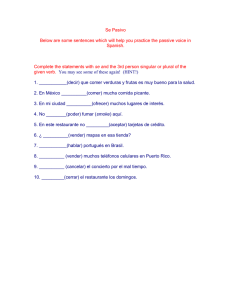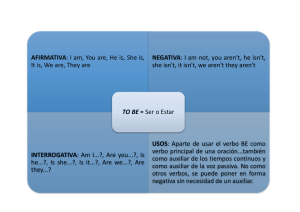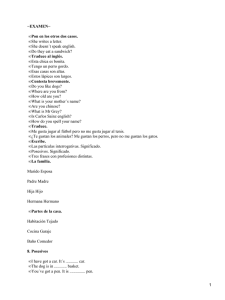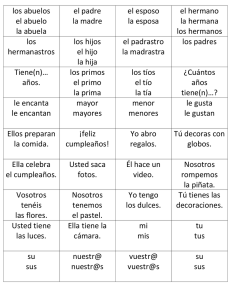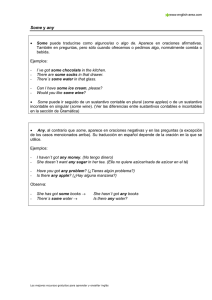Anexo 7
Anuncio
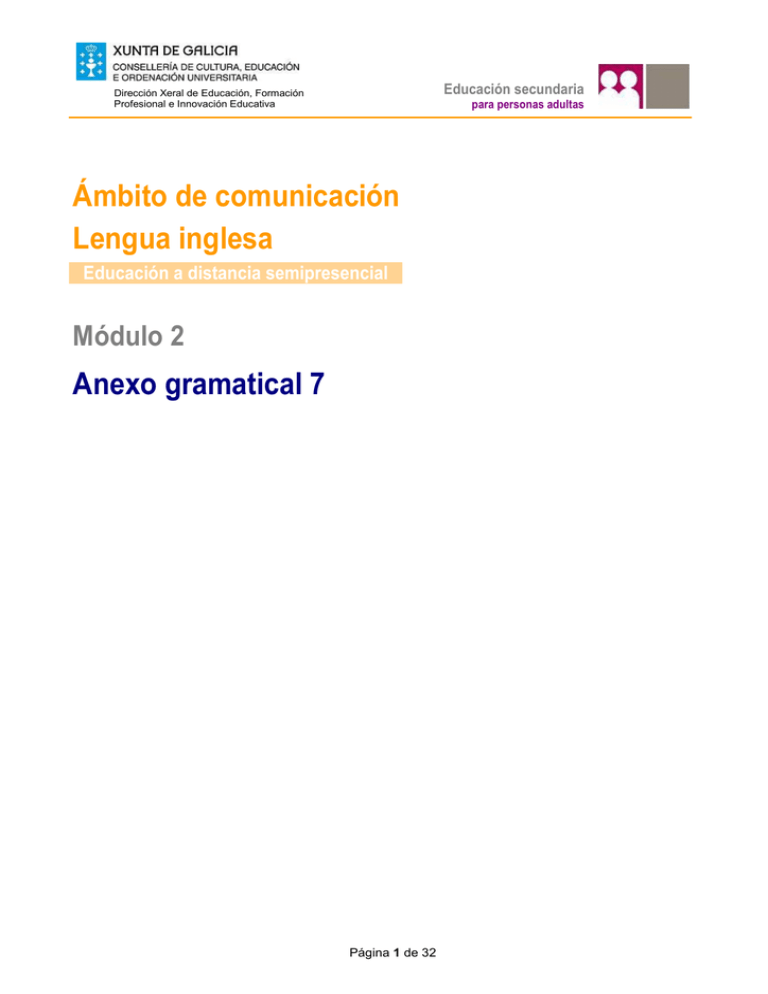
Educación secundaria Dirección Xeral de Educación, Formación Profesional e Innovación Educativa para personas adultas Ámbito de comunicación Lengua inglesa Educación a distancia semipresencial Módulo 2 Anexo gramatical 7 Página 1 de 32 Índice 1. Introducción...............................................................................................................3 1.1 2. Descripción del anexo gramatical ................................................................................. 3 Secuencia de contenidos y actividades ..................................................................4 2.1 El presente continuo ..................................................................................................... 4 2.1.1 2.1.2 2.1.3 2.1.4 2.2 2.3 Distinción entre el presente simple y el presente continuo.......................................... 11 Nombres contables e incontables: a/an y some/any ................................................... 14 2.3.1 2.3.2 2.4 2.5 2.6 2.7 Reglas ortográficas de la forma -ing ..................................................................................................................4 Forma afirmativa ................................................................................................................................................5 Forma negativa ..................................................................................................................................................7 Forma interrogativa ............................................................................................................................................9 Nombres contables e incontables ....................................................................................................................14 How much / How many? ..................................................................................................................................18 Comprensión escrita................................................................................................... 19 Actividades de autoevaluación.................................................................................... 21 Vocabulario básico de la unidad ................................................................................. 22 Soluciones de las actividades ..................................................................................... 26 Página 2 de 32 1. Introducción 1.1 Descripción del anexo gramatical En este séptimo anexo vamos a abordar los siguientes contenidos: El presente continuo. La distinción entre sustantivos contables e incontables. El empleo de a/an y some/any. Las preguntas con how much y how many. Los deportes y los verbos de acción. Las prendas de ropa, calzado y accesorios. Vocabulario relacionado con la comida y con la bebida. Página 3 de 32 2. Secuencia de contenidos y actividades 2.1 El presente continuo Empleamos el presente continuo para hablar de acciones que están ocurriendo en el momento en que se está hablando. – He's playing football now (está jugando al fútbol ahora). – What are you doing at the moment? (¿Qué estás haciendo en este momento?). El presente continuo se forma con el presente simple del verbo to be y la forma -ing del verbo principal. 2.1.1 Reglas ortográficas de la forma -ing Normalmente añadimos al verbo -ing. – play - playing – wear - wearing Con los verbos acabados en -e, omitimos la -e y añadimos -ing. – come - coming – drive - driving Con los verbos terminados en -ie, cambiamos el –ie por –ying. – die – dying – lie - lying Con los verbos acabados en sílaba tónica y consonante-vocal-consonante doblamos la última consonante y le añadimos al verbo -ing (excepto si la última consonante es -w o -y). – sit - sitting – run - running Pero... – listen - listening – show - showing Actividades propuestas Página 4 de 32 S1. Escriba estos verbos en la forma –ing y clasifique las formas verbales en el cuadro. swim drive throw sleep die carry play run listen come lie do wear hit cycle sit study get Ortografía de la forma -ing +-ing -e + -ing -ie + -ing Doble consonante + -ing 2.1.2 Forma afirmativa Forma afirmativa: to be en afirmativo + -ing Forma no contraída Forma contraída Singular I am playing You are He/she/it is – Yo estoy jugando I'm – Yo estoy jugando – Tú estás jugando You're – El / ella está jugando He/she/it's playing – Tú estás jugando – El / ella está jugando Plural – Nosotros We are You are estamos jugando playing – Vosotros estáis ju- gando They are – Ellos están jugando – Nosotros We're You're estamos jugando playing They're – Vosotros estáis jugando – Ellos están jugando El presente continuo se forma con el presente simple del verbo to be y la forma -ing del verbo principal. Actividades propuestas S2. Relacione cada oración con su significado. 1. They are doing athletics. – a. La mujer anciana lleva un bolso. 2. I'm wearing a black cap. – b. Llevo una gorra negra. 3. She's eating some cheese. – c. Están haciendo atletismo. Página 5 de 32 – d. Está comiendo queso. 5. The old woman's carrying a bag. – e. Estás tomando un café. Complete con am/are/is y escoja la respuesta adecuada. Después contraiga el verbo to be. Picture S3. 4. You're drinking black coffee. Activity 1. She [_________] S4. 2. He [_________] 3. They [_________] 4. I [_________] – a) skating – a) swimming – a) swimming – a) cycling – b) running – b) running – b) ice-skating – b) running – c) swimming – c) jumping – c) skiing – c) doing athletics Observe la fotografía, complete con la forma adecuada del verbo entre paréntesis y describa la ropa, el calzado y los accesorios que lleva cada miembro de la familia. Modern family 1. My name's Luke Dunphy. I [_________________] (sit) on the floor next to my sister Alex. I [_________________] (wear)... 2. She's Alex, my sister. She [_________________] (sit) on the floor next to me. She [_________________] (wear) ... 3. She's my other sister, Haley. She [_________________] (sit) on the sofa next to my mum. She [_________________] (wear)... 4. She's my mother, Claire. She [_________________] (sit) on the sofa next to her brother, Mitchell. She [_________________] (talk) to him at the moment. She [_________________] (wear) ... Página 6 de 32 5. He's my father, Phil Dunphy. He [_________________] (stand) next to my grandfather's new wife, my "grandma" Gloria. He [_________________] (smile) now. He [_________________] (wear) ... 6. He's Mitchell, my uncle. He [_________________] (sit) next to my mother. He [_________________] (listen) to her. He [_________________] (wear)... 7. He's Cameron, my uncle's husband. He [_________________] (wear) ... He [_________________] (point) at Gloria. He [_________________] (hold) his daughter in his arms. Her name's Lily. She [_________________] (wear) ... 8. My grandfather Jay [_________________] (stand) next to Cameron. He's married to Gloria. He [_________________] (wear) ... 9. They are Gloria and Manny, her son. They are from Colombia but they [_________________] (live) here now. Gloria [_________________] (look) at Lily. Manny [_________________] (wear) ... 2.1.3 Forma negativa Forma negativa: to be en negativo + -ing Forma no contraída Forma contraída Singular I am not You are not playing He/she/it is – Yo no estoy jugando I'm not – Tú no estás jugando You aren't – El / ella no está jugando He/she/it isn't – Yo no estoy jugando playing – Tú no estás jugando – El/ella no está jugando Plural – Nosotros We are not You are not They are not no estamos jugando playing – Vosotros no estáis jugan- do – Ellos no están jugando – Nosotros no estamos ju- We aren't You aren't They aren't gando playing – Vosotros no estáis jugando – Ellos no están jugando La negativa del presente continuo se forma añadiendo not detrás del verbo to be. Las formas contraídas se usan más frecuentemente. Página 7 de 32 Actividades propuestas S5. Observe el cuadro. A continuación, complete las oraciones con la forma afirmativa o negativa de los verbos entre paréntesis. Penélope Cruz Halle Berry and Gwyneth Paltrow You 1. Penélope Cruz [_________________] (wear) a black dress. 2. Halle and Gwyneth [_________________] (wear) black dresses. 3. I [_________________] (wear) a black dress. 4. Penélope Cruz [_________________] (smile). 5. Halle and Gwyneth [_________________] (smile). 6. I [_________________] (smile). 7. Penélope, Halle and Gwyneth [________________] (hold) an Oscar award. 8. I [_________________] (hold) an Oscar award. Observe las ilustraciones y corrija las oraciones. Emplee los verbos del recuadro en el presente continuo. Verbs Negative Picture catch - hit - jump - kick - throw Activity S6. (catch the ball) – She isn't catching the ball. 1. (run) – They _____ 2. (throw the ball) 3. (hit the ball) – _____ She's hitting the ball. Página 8 de 32 – _____ 4. (kick the ball) – _____ 2.1.4 Forma interrogativa Forma interrogativa: to be en interrogativo + -ing Preguntas Respuestas cortas Singular Am I ¿Estoy jugando? Playing? Are you Is he/she/it ¿Estás jugando? ¿Está jugando? – Yes, you are. – No, you aren't. – Yes, I am. – No, I'm not. – Yes, he/she/it is. – No, he/she/it isn't. Sí. No. Sí. No. Sí. No. [...] Plural Are we ¿Estamos jugando? Playing? Are you Are they ¿Estáis jugando? ¿Están jugando? – Yes, you are. – No, you aren't. – Yes, we are. – No, wem aren't. – Yes, they are. – No, they aren't. Sí. No. Sí. No. Sí. No. Fíjese: En las respuestas cortas no usamos la forma -ing. En las respuestas cortas afirmativas no podemos emplear la forma contraída. – Yes, I am. – Yes, I'm. Actividades propuestas Observe el cuadro, complete las preguntas y conteste con la respuesta corta correspondiente. Two different sports camps Keith and Amy are brother and sister. This month they're going to two different summer camps. Amy is going to a water sports camp and Keith is going to a winter sports camp. This is what they are doing now. Time 8:00 h 11:30 h Amy S7. Página 9 de 32 17:00 h 23:00 h Keith Ej.: Are they sleeping? Yes, they are. S8. 23.00 1. [__] she [_________]? Yes, she is. 17.00 2. [__] he [_________]? (ice-skate) [_________________] 17.00 3. [__] he [_________]? Yes, he is. 11.30 4. [__] she [_________]? (swim) [_________________] 11.30 5. [__] they [_________]? (have breakfast) [_________________] 8.00 6. [__] they [_________]? Yes, they are. 8.00 Corrija los errores de las oraciones. 1. I cycling at the moment. 2. You are wearing a black suit tonight? 3. Is she skiing? Yes, she's. 4. He's hiting the ball. 5. Peter and I am eating lettuce. 6. The basketball player is throwwing the ball. S9. Complete las frases con el presente continuo del verbo entre paréntesis. 1. [_________________] (I / wear) a red dress. 2. [_________________] (you / play) hockey at the moment? No, [_______]. 3. [_________________] (your dad / work) now? Yes, [_______]. 4. [_________________] (Tina and I / eat) pizza right now. Página 10 de 32 2.2 Diferencias entre el presente simple y el presente continuo Presente simple Presente continuo Hábitos y acciones regulares. Acciones que están ocurriendo ahora. Ej.: He visits his friends every Sunday. / Visita a sus amigos todos los domingos. Ej. What are you doing now? / ¿Qué estás haciendo ahora? – Expresiones típicas: – Expresiones típicas: – Adverbios de frecuencia [always (siempre), usually – – – – – (normalmente), often (a menudo), sometimes (a veces), never (nunca)…]. Every day / week... (todos los días / semanas…). On Mondays / Tuesdays… (los lunes / martes…). In the morning / in the afternoon / in the evening / at night...(por la mañana / tarde / noche). In winter / in autumn (en el invierno / en el otoño…). Once a week / twice a day / three times a month... (una vez a la semana / dos veces al día / tres veces al mes…). – (Right) now [ahora (mismo)]. – At the moment (en este momento). – At present (en el presente, ahora). – Look! / Listen! (¡Hola! /¡ Escucha!) Antes de continuar, revise la formación del presente simple en el módulo 1, unidades 1 (verbo to be), 2 y 3 (verbos frecuentes y there is / there are) y en la unidad 5 (verbo have got) de este módulo. Recuerde que: Hay tres verbos (to be, have got y there is/there are) que no llevan auxiliar en la forma negativa e interrogativa. – He isn't from China. – Have you got a sister? – Is there any fruit in the fridge? – He doesn't be from China. – Do you have got a sister? – Do there is any fruit in the fridge? En los demás verbos... – Forma afirmativa: coincide con el infinitivo del verbo, excepto la tercera persona del singular (he/she/it), que añade -s. – I/you/we/they play football. – He/she/it plays football. – Forma negativa: se forma colocando don't /doesn't delante del infinitivo. – I/you/we/they don't play football. – He/she/it doesn't play(s) football. – Forma interrogativa: se forma colocando do /does delante del sujeto. – Do I/you/we/they play football? – Does he/she/it play football? Página 11 de 32 – Respuestas cortas: en ellas empleamos el sujeto y el auxiliar (do/does en las respuestas cortas afirmativas y don't/doesn't en las respuestas cortas negativas). – Do you play football? Yes, I do. / No, I don't. – Does he play football? Yes, he does. / No, he doesn't. Actividades propuestas S10. Antes de continuar, compruebe que recuerda la formación del presente simple. Complete estas oraciones con el presente simple del verbo entre paréntesis. 1. [________] (he / play) table tennis once a week. 2. [________] (you / have got) your slippers under the bed? No, [________]. 3. [________] (there is) any sugar in the cupboard? Yes, [________]. 4. [________] (you / go sailing) on Sundays? Yes, [________]. 5. [________] (he / not do) judo in the morning. 6. [________] (Tokyo/ be) in Japan? Yes, [________]. 7. [________] (Sam / live) in San Francisco? No, [________]. 8. [________] (We / not / like) eating vegetables. S11. Coloque las oraciones en el cuadro, según su tiempo verbal y su significado. 1. Please be quiet! I'm working. 2. What do you usually do at the weekend? 3. Look at that man! He's running very fast. 4. It rains a lot in winter. 5. Listen! Lady Gaga is singing a beautiful song. 6. I always eat cereal in the morning. 7. She's sending a text message at the moment. 8. My sister plays rugby twice a week. Presente simple Presente continuo Página 12 de 32 S12. Coloque en el cuadro las siguientes expresiones temporales, en el tiempo verbal que le corresponda: every day - at the moment - right now - never - twice a month - on Sundays - three times a day - now - every evening - sometimes. Presente simple Presente continuo S13. Observe las ilustraciones y diga lo que hace cada persona normalmente y lo que está haciendo ahora. Emplee el presente simple y el presente continuo. Picture Sports life Job My name's Ronaldinho 1. My name's Rafael – I'm a football player. Now – I play football. S14. I'm having a bath. 2. My name's Michael 3. My name's Aijon Nadal – I'm a tennis player – [_____________] Phelps – I'm a swimmer – [_____________] Philips – I'm a judo expert – [_____________] [_________________] [_________________] [_________________] Escoja la respuesta adecuada. 1. We play / are playing football every evening. 2. I never drink / 'm never drinking alcohol at the weekend. 3. We eat / are eating fish twice a week. 4. Lisa wears / is wearing a new T-shirt at the moment. 5. What do you do / are you doing on Mondays? 6. What does Gina do / is Gina doing right now? 7. Listen! Somebody sings / 's singing. S15. Complete con el presente simple o continuo del verbo entre paréntesis. 1. [______________] (you / play) golf every Sunday? 2. [______________] (Paul / use) the computer now? 3. [______________] (we / not / go) swimming on Thursdays. 4. What [______________] (she / do)? She's a teacher. 5. [______________] (your brother / watch) the basketball match right now. 6. [______________] (my sister / not / usually / go) to work by car. Página 13 de 32 2.3 Nombres contables e incontables: a/an y some/any 2.3.1 Nombres contables e incontables En inglés hay nombres contables (countable) e incontables (uncountable): Contables: un nombre contable se refiere a algo que se puede contar. one tomato two tomatoes three tomatoes Incontables: un nombre incontable se refiere a algo que no se puede contar. No puede ser plural. Es siempre singular. one milk, two milks... Algunos nombres pueden ser contables e incontables, pero su significado cambia. a pizza a cake some pizza some cake Nombres contables En la forma singular, empleamos a/an delante del nombre. a/an + nombre singular a pear (una pera) a carrot (una zanahoria) a + nombre que empieza por consonante an apple (una manzana) an onion (una cebolla) an + nombre que empieza por sonido vocálico En el plural, empleamos some/any delante del nombre en plural. Nombres incontables Los nombres incontables no tienen forma plural. El verbo siempre va en singular. – The rice is delicious (el arroz está delicioso). – The rice are delicious. Pueden emplearse con el artículo the (el, la, los, las), pero nunca con el artículo a/an (un, una). – The milk is in the fridge (la leche está en la nevera) – I need a milk. (preciso leche) En plural, empleamos some/any delante del nombre en plural. Página 14 de 32 Con los nombres incontables empleamos some / any. Su uso sigue las mismas normas que con los nombres contables plurales. – I need some milk (necesito leche) Some/any en nombres contables plurales – There are some eggs in the fridge. Some Frases afirmativas (+) [Hay (algunos) huevos en la nevera] – Would you like some biscuits? Ofrecimientos y peticiones [¿Te apetecen unas galletas?] Esperamos que la respuesta sea Yes. – Can you bring me some tomatoes from the market? [¿Puedes traerme unos tomates del mercado?] – Have you got any potatoes left? Frases negativas (-) Any [¿Te quedan patatas?] Preguntas (?) – We haven't got any oranges. *excepto ofrecimientos y peticiones [No tenemos naranjas / ninguna naranja] Some/Any en nombres incontables – I need some salt. Some Frases afirmativas (+) [Necesito (algo de) sal] – Would you like some tea? Ofrecimientos y peticiones [¿Te apetece un té?] Esperamos que la respuesta sea Yes. – Can you lend me some salt? [¿Puedes dejarme (algo de) sal?] – Have you got any sugar left? Frases negativas (-) Any [¿Te queda azúcar (algo de)?] Preguntas (?) – *excepto ofrecimientos y peticiones Resumo Página 15 de 32 We haven't got any bread. [No tenemos (nada de) pan] Actividades propuestas S16. S17. Escriba el nombre del alimento y diga si es un nombre contable (C) o incontable (U). Complete las oraciones con a / an o some / any. 1. I need to buy [_______] peas and [_______] beans at the supermarket. 2. We haven't got [_______] eggs, so we can't make an omelette. 3. She's eating [_______] sandwich at the moment. 4. There are [_______] people outside the cinema. 5. Would you like [_______] pineapples? 6. Is she wearing [_______] anorak? 7. Are there [_______] strawberries left? 8. I haven't got [_______] sausages. Can you bring me [_______]? S18. Observe las ilustraciones y complete con el nombre del alimento. Diga si se trata de nombres contables (C) o incontables (U) y complete con a/an o some. some cheese (U) 1. 2. 3. 4. 5. 6. 7. 8. 9. 10. 11. Página 16 de 32 12. S19. S20. 13. 14. 15. 16. 17. Observe las ilustraciones, lea las oraciones y complete con el nombre del alimento y a/an o some/any. Amanda is very thirsty but she hasn't got any water. 1. I would like ____ ........... for dinner. 2. Amanda is having ____ ........... 3. Would you like ____ ...........? 4. We haven't got ____ ....... left. We need to buy ____. 5. Can I have ____ ...........? 6. I'm preparing ____ ........... but I haven't got ____ ........... 7. I would like ____ ....... Have you got ____? Complete este diálogo en el restaurante con a/an o some/any. – WAITER: Would you like to order now? – JOHN: Yes, we are ready to order. – LARA: Have you got [_____] (1) fish soup? – WAITER: No, we haven't got ____ (2). I'm sorry. But we have got [_____] (3) tomato soup left. Would you like [_____] (4)? – LARA: Oh, OK. So, the tomato soup for me. – JOHN: And... can I have [_____] (5) Spanish omelette? What about you, Mary? – LARA: Oh, no! Not for me. I don't eat [_____] (6) eggs. I have cholesterol! – WAITER: What about the main course? We have [_____] (7) chicken and [_____] (8) peas. – JOHN: Well, I don't eat [_____] (9) meat so I want [_____] (10) grilled fish. Can I have [_____] (11) boiled potatoes with it? – WAITER: Of course, sir. And for you, madam? – LARA: I would like [_____] (12) tuna in green sauce, please. – WAITER: Would you like [_____] (13) wine with your meal? – JOHN: We’d like to have [_____] (14) white wine, please. What do you think, Lara? – LARA: Yes, [_____] (15) bottle of white wine. – WAITER: OK. Thank you very much. Página 17 de 32 2.3.2 How much / how many? how much? / how many? How much (¿Cuánto? / ¿cuánta?) How many (¿Cuántos? / ¿cuántas?) + nombres incontables + nombres contables plurales – How much sugar do you need? ¿Cuánto azúcar necesitas? – How many strawberries do you need? ¿Cuántas fresas precisas? Actividades propuestas S21. Complete con how much o how many. 1. [___________] rice have you got? 2. [___________] jam is there in the fridge? 3. [___________] cookies are there in the plate? 4. [___________] wine do you drink every day? 5. [___________] T-shirts are you wearing now? S22. Complete las oraciones con a/an, some/any, how much / how many. 1. Would you like [____] water? Yes, please. [____] glass of water. 2. [____] [____] biscuits are there? 3. There is [____] bread. It's enough. We don't need to buy [____]. 4. There aren't [____] apples left. Please go to the supermarket and buy [____]. 5. In summer I like having [____] yoghourt after lunch. I need to buy [____] because there isn't [____] yoghourt left. 6. Are you eating [____] sandwich? Yes, but I would like [____] crisps too. 7. [____] wine do you drink a day? Página 18 de 32 2.4 Comprensión escrita S23. Lea el cómic y responda a estas preguntas. Escriba oraciones completas. 1. Where are the Beckhams going today? 2. When do the Beckhams usually go shopping? 3. Where does David want to go at first? 4. What are the Beckhams having for lunch today? S24. Lea las siguientes oraciones y colóquelas en el cuadro. 1. They always go shopping on Saturdays. 2. David is looking at the shopping list. 3. Victoria is trying on a beautiful dress. 4. The Beckhams are leaving the shop. Presente simple Presente continuo S25. Lea las oraciones y clasifique los nombres subrayados. Colóquelos en el lugar correspondiente del esquema. 1. We're having some Spanish paella. 2. There isn't any rice left. 3. Can you bring me some (rice)? 4. Are there any carrots at home? 5. Take some (carrots). 6. Victoria is trying on a beautiful dress. 7. I've got an idea. A Contable Singular A + consonante Incontable Plural An + consonante Some / Any Some Any – Frases afirmativas – Frases negativas – Peticiones y ofrecimientos – Preguntas Página 19 de 32 Today it's Saturday. The Beckhams are going to Walmart. They always go shopping on Saturdays. It's very early in the morning, so there aren't any people in the shop. David is looking at the shopping list. David and his sons are choosing some vegetables for their paella. But… where is Victoria? In the meantime, Victoria is trying on a beautiful dress… It's 4.00 in the afternoon. The Beckhams are paying at the checkout. The Beckhams are leaving the shop. Victoria is very tired and David is carrying all the bags. The boys are looking at a huge chicken. Página 20 de 32 2.5 Actividades de autoevaluación S26. Complete las oraciones con el presente simple o el presente continuo del verbo entre paréntesis. 1. Listen! [___________] (Sam / sing) in the bathroom. 2. [___________] (my uncle/ never / wear) T-shirts and jeans. 3. [___________] (you / walk) to work every day? 4. [___________] (you / try on) a black skirt at the moment? 5. [___________] (my grandmother / not get up) early in the morning. 6. [___________] (Tom's nephew / run) in the park now. 7. Be quiet! This is a library and [___________] (we / study). 8. [___________] (Teddy / do) judo once a week. S27. Complete las oraciones con a/an, some/any. Tom: Let’s go for a picnic in the park. Sarah: OK. We can make [___________] (1) sandwiches. What do we need? Tom: We haven’t got [__________] (2) bread. Can you buy [__________] (3)? Sarah: Yes, sure. What about butter? Tom: We’ve got [_________] (4). But we need to buy [_________] (5) cheese. Sarah: OK, and is there [___________] (6) orange juice in the fridge? Tom: Yes, there is [___________] (7). Sarah: Good. Do we need [___________] (8) apple or two? Tom: Just [___________] (9) apple for you because I don't like apples. Sarah: Oh dear! I haven’t got [___________] (10) money to buy the bread! Tom: Don’t worry. I’ll lend you [___________] (11). S28. Complete las oraciones con how much / how many 1. [___________] bread do you eat every day? 2. [___________] wine is there in the fridge? 3. [___________] trousers do you buy every year? 4. [___________] pineapples are there? Página 21 de 32 2.6 Vocabulario básico de la unidad Deportes y verbos de acción Common sports. Play... (jugar a...) English Otros deportes Castellano basketball baloncesto football fútbol golf hacer ciclismo vela hacer esquí (acuático) swim nadar tenis de mesa tennis tenis volleyball patinar (sobre hielo) (water) ski rugby table tennis to cycle to sail hockey rugby Castellano to (ice-) skate golf hockey English Do... (hacer...) athletics voleibol atletismo judo yudo Action verbs (verbos de acción) English Castellano English to catch (Am. football) coger to hit (golf) to jump (basketball) saltar to kick (football) to run (athletics) correr to throw (basketball) Castellano golpear dar una patada tirar Ropa y accesorios Footwear (calzado) English Outerwear (ropa de abrigo) Castellano boots botas high heels an anorak tacones sandals zapatos chancletas trainers deportivos a coat a dress jeans abrigo cazadora, chaqueta a raincoat Footwear (calzado) English chaqueta americana a jacket thongs / flip flops Castellano anorak a blazer sandalias shoes English impermeable, gabardina Outerwear (ropa de abrigo) Castellano vestido English a blouse vaqueros a cardigan Página 22 de 32 Castellano blusa chaqueta de punto a mini-skirt minifalda a jersey jersey shorts pantalones cortos a jumper jersey a skirt falda a shirt camisa a suit traje a sweater jersey a tracksuit chándal trousers pantalones a uniform uniforme a sweatshirt sudadera a T-shirt camiseta a waistcoat chaleco Sleepwear (ropa de dormir) English a dressing gown a nightgown Underwear (ropa interior) Castellano English bata a bra camisón knickers Castellano sujetador bragas a pyjama pijama pants calzoncillos slippers zapatillas socks calcetines tights medias Accessories (accesorios) English Castellano English Castellano a bag bolso a belt cinturón a bikini bikini a bracelet pulsera braces tirantes earrings pendientes gloves a necklace a swimming costume a cap guantes glasses a hat collar a scarf traje de baño a tie visera, gorra gafas sombrero bufanda, fular corbata Wear: llevar puesto. – I wear glasses (uso, llevo gafas). I'm wearing a skirt now (llevo puesta una falda ahora). Carry: llevar. – I'm carrying a bag (llevo un bolso). Fíjese en que: Empleamos a (y no an) delante de uniform. Hay algunhas prendas de ropa que son plurales: trousers, jeans, shorts, knickers, pants, tights, el calzado... – I'm wearing a T-shirt (llevo puesta una camiseta). Pero: Página 23 de 32 – I'm wearing a green trousers. – I'm wearing green trousers. Comidas y bebidas Fruit (fruta) English apples Vegetables (hortalizas) Castellano English Castellano manzanas beans habas bananas plátanos carrots zanahorias cherries cerezas lettuce lechuga lemons limones onions cebollas oranges naranjas peas guisantes peaches melocotones peppers pimientos pears peras potatoes patatas pineapples piñas salad ensalada strawberries moras tomatoes tomates Breakfast (desayuno) English Meat and fish (carne y pescado) Castellano English Castellano bacon bacon, panceta bread pan butter mantequilla fish pescado cereal cereales ham jamón cheese queso hamburgers eggs huevos hotdogs jam mermelada lamb ternero milk leche pork cerdo pancakes crepes sausages sausages salchichas steak bistec tostadas tuna atún toast beef carne de vaca chicken Snacks and desserts (refrigerios y postres) English biscuits cakes (C) / cake (U) chocolate (U)/chocolates (C) crisps ice cream popcorn hamburguesas perritos calientes salchichas Drinks (bebidas) Castellano galletas pollo English beer bizcocho, pastel chocolate / bombones patatas fritas helado coffee cola / coke (orange, apple) juice tea copos de maíz water Página 24 de 32 Castellano cerveza café refresco de cola zumo de naranja, de manzana té agua yoghourt yogur wine vino Cooking and condiments (ingredientes y condimentos) English oil pepper salt Others (otros) Castellano English Castellano aceite pizzas (C) / pizza (U) pizza rice arroz pimienta sal sandwiches sugar azúcar soup vinegar vinagre spaghetti Los nombres contables están en plural y los incontables en singular. Página 25 de 32 bocadillos sopa espaguetis 2.7 Soluciones de las actividades S1. Ortografía de la forma -ing +-ing -e + -ing -ie + -ing Doble consonante + -ing sleeping playing wearing studying throwing carrying listening doing coming driving cycling dying lying swimming sitting running hitting getting S2. 1c - 2b - 3d - 4e - 5a S3. 1. She is (she's) skating. 2. He is (he's) running. 3. They are (they're) skiing. 4. I am (I'm) cycling. S4. 1. My name's Luke Dunphy. I'm sitting on the floor next to my sister Alex. I'm wearing a green T-shirt, brown shorts and brown trainers. 2. She's Alex, my sister. She's sitting on the floor next to me. She's wearing a yellow T-shirt, glasses, blue jeans and blue trainers. 3. She's my other sister, Haley. She's sitting on the sofa next to my mum. She's wearing a green and black top, a jacket and black trousers. 4. She's my mother, Claire. She's sitting on the sofa next to her brother, Mitchell. She's talking to him at the moment. She's wearing a red sweater, blue jeans and white sandals. 5. He's my father, Phil Dunphy. He's standing next to my grandfather's new wife, my "grandma" Gloria. He's smiling now. He's wearing a blue shirt, a grey T-shirt and jeans. 6. He's Mitchell, my uncle. He's sitting next to my mother. He's listening to her. He's wearing a grey sweater, a purple shirt, a tie, grey trousers and brown shoes. 7. He's Cameron, my uncle's husband. He's wearing a blue and white shirt, jeans and green shoes. He's pointing at Gloria. He's holding his daughter in his arms. Her name's Lily. She's wearing a red dress. Página 26 de 32 8. My grandfather Jay's standing next to Cameron. He's married to Gloria. He's wearing a red T-shirt. 9. They are Gloria and Manny, her son. They are from Colombia but they're living here now. Gloria's looking at Lily. Manny's wearing an orange and white T-shirt. S5. 1. isn't wearing. 2. aren't wearing. 3. 'm wearing (afirmativa) / 'm not wearing (negativa). 4. is smiling. 5. aren't smiling. 6. 'm smiling (afirmativa) / 'm not smiling (negativa) 7. are holding. 8. 'm holding (afirmativa) / 'm not holding (negativa) 1. They aren't running. They're jumping. 2. They aren't throwing the ball. They're kicking the ball. 3. He isn't hitting the ball. He's throwing the ball. 4. She isn't kicking the ball. She's catching the ball. 1. Is she waterskiing? Yes, she is. 2. Is he ice-skating? Yes, he is. 3. Is he skiing? Yes, he is. 4. Is she swimming? No, she isn't. 5. Are they having breakfast? No, they aren't. 6. Are they brushing their teeth? Yes, they are. 1. I'm cycling at the moment. 2. Are you wearing a black suit tonight? 3. Is she skiing? Yes, she is. 4. He's hitting the ball. 5. Peter and I are eating lettuce. 6. The basketball player is throwing the ball. S6. S7. S8. S9. 1. I'm wearing 2. Are you playing...? No, I'm not. 3. Is your dad working? Yes, he is. 4. Tina and I are eating Página 27 de 32 S10. 1. He plays 2. Have you got...? No, I haven't. 3. Is there...? Yes, there is. 4. Do you go sailing...? Yes, I do. 5. He doesn't do 6. Is Tokyo...? Yes, it is. 7. Does Sam live...? No, he doesn't 8. We don't like S11. 2. What do you usually do at the weekend? Presente simple 4. It rains a lot in winter. 6. I always eat cereal in the morning. 7. My sister plays rugby twice a week. 1. Please be quiet! I'm working. Presente continuo 3. Look at that man! He's running very fast. 5. Listen! Lady Gaga is singing a beautiful song. 7. She's sending a text message at the moment. S12. Presente simple Presente continuo every day - never - twice a month - on Sundays - three times a day - every evening sometimes at the moment - right now - now S13. 1. I play tennis. I'm driving a car. 2. I swim. I'm eating a sandwich. 3. I do judo. I'm drinking juice. S14. 1. play 2. never drink 3. eat 4. is wearing 5. do you do 6. is Gina doing 7. is singing Página 28 de 32 S15. 1. do you play 2. is Paul using 3. we don't go 4. does she do 5. your brother's watching 6. my sister doesn't usually go S16. 1. hamburger (C) 2. bean (C) 3. bread (U) 4. onion (C) 5. egg (C) 6. cheese (U) 7. juice (U) 8. pancake (C) S17. .1. some - some 2. any 3. a 4. some 5. some 6. an 7. any 8. any - some S18. 1. some beer (U) 2. a uniform (C) 3. some money (U) 4. some popcorn (U) 5. some steak (U) 6. some meat (U) 7. a pepper (C) 8. a pineapple (C) 9. some wine (U) Página 29 de 32 10. some cereal (U) 11. some chocolate (U) 12. some ham (U) 13. some fruit (U) 14. some rice (U) 15. some jam (U) 16. some oil (U) 17. a sausage (C) S19. 1. an egg 2. some yoghourt 3. some sugar 4. any butter - some 5. some salt 6. a cake - any strawberries 7. some crisps - any S20. 1. any 2. any 3. some 4. some 5. a 6. any 7. some 8. some 9. any 10. some 11. some 12. some 13. some 14. some 15. a Página 30 de 32 S21. 1. how much 2. how much 3. how many 4. how much 5. how many S22. 1. some - a 2. how many 3. some - any 4. any - some 5. some - some - any 6. a - some 7. how much S23. 1. They're going to Walmart. 2. They go shopping on Saturdays. 3. He wants to go to the sports department. 4. They're having some Spanish paella. S24. Presente simple 1. They always go shopping on Saturdays. 2. David is looking at the shopping list. Presente continuo 3. Victoria is trying on a beautiful dress. 4. The Beckhams are leaving the shop. S25. Página 31 de 32 S26. 1. Sam's singing 2. my uncle never wears 3. do you walk 4. are you trying on 5. my mother doesn't get up 6. Tom's nephew is running 7. we're studying 8. Teddy does judo S27. 1. some 2. any 3. some 4. some 5. some 6. any 7. some 8. an 9. an 10. any 11. some S28. 1. how much 2. how much 3. how many 4. how many Página 32 de 32
